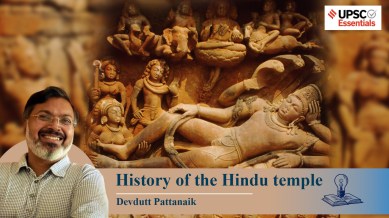Art and Culture with Devdutt Pattanaik | How Hindu temples survived political upheavals and philosophical shifts
It was only around 2,000 years ago that we began to see the first sculptures of Hindu gods in Mathura. But Hindu temples have not remained static for millennia, and have evolved over time to adapt to all kinds of challenges and shifts in philosophies.

The Hindu temple, as we know it today, is not 5,000 years old. In the earliest times, people did not worship their deities in enclosed sanctuaries or with sculpted images. Instead, the divine was experienced directly in nature – trees, animals, rivers, mountains, and rocks all served as sacred forms.
It was only around 2,000 years ago that we began to see the first sculptures of Hindu gods in Mathura. Interestingly, images of Shiva, Vishnu, and the Goddess also appear on Kushan coins from the same period, though scholars debate whether these are truly Hindu deities or representations shaped by Zoroastrian and Greek influences.
From nature worship to image worship
The next step was to enclose these images within structures. At Bhitargaon in Uttar Pradesh, dating to around 500 AD, we find a brick temple where images were placed inside a sanctum. At Nachna in Madhya Pradesh, a Shiva temple was built that attempted to replicate the ecosystem of the Himalayas—its roof shaped like a mountain, and river goddesses Ganga and Yamuna carved at the doorway.
At Deogarh near Jhansi, we find one of the earliest Vishnu temples made entirely of stone. The temple features iconic images of Vishnu reclining on the serpent Ananta, and Vishnu riding Garuda with four arms, panels from the life of Rama and Krishna. These are the beginnings of classical temple architecture.
Rock-cut and freestanding temples
This phase was followed by the era of monumental rock-cut temples after 600 AD. Here, the art became truly gigantic. The caves of Ellora and Elephanta, the temples of Pattadakal in Karnataka, and the rock-cut carvings of the Shore Temple at Mamallapuram near Chennai all showcase grand depictions of Shiva and Vishnu. These were not just places of worship but also declarations of royal power, carved directly into mountains and cliffs, as if to demonstrate that kings could shape the very earth.
By the 8th century, we see even more ambitious projects. At Ellora, the Kailasanath Temple was carved out of a single rock to resemble a mountain palace for Shiva. This period also gave rise to freestanding temples, built stone by stone rather than carved from rock. These appear in Hampi and Pattadakal in Karnataka, as well as in Kanchipuram, home to the famous Kailasanath Temple.
The freestanding temple marks the shift from experimental forms to enduring architectural styles. By the 10th century, temple architecture exploded in complexity: curvilinear ‘nagara’ styles of the north, and pyramidal ‘vimana’ style of the south. Temples were built on Tantric mandalas, functioning not only as houses of gods but as centres of ritual power. Within them, priests performed Tantric rites to attract wealth, protection, and fortune.
These early temples were very different from the devotional shrines most of us are familiar with today. They were closer to ritual laboratories, where geometry, art, and mantra combined to create zones of cosmic energy.
How temples survived change and invasions
Later, with the rise of the Bhakti movement, temples changed once again. The focus moved from secret Tantric rituals to public participation. People were encouraged to sing, dance, and actively worship. This is when great Vaishnava temples such as Jagannath in Puri and Srirangam in Tamil Nadu became popular. Here, the temple became the people’s house of God.
Contrary to popular belief, many temples were built in India in the centuries immediately after the attack on the Somnath temple by Mahmud of Ghazni in the 11th century. The famous Khajuraho temple complex, for example, was built in the 11th century. It was later abandoned when the trade route shifted. The Lingaraj temple complex of Bhubaneswar was also built around this time. Mansingh, Akbar’s Rajput general, built the Govindraj temple at Vrindavan in the 16th century. It was later vandalised by Aurangzeb in the 17th century.
When Muslim warlords did attack temples, people often shifted to small portable images of deities housed in private homes or relocated to safe haveli-style residences in Rajasthan. In Bengal, during the 17th century, new terracotta temples dedicated to Krishna appeared, reflecting both local artistic traditions and devotional needs.
A fresh wave of temple construction came with the decline of the Mughal Empire and the rise of the Marathas. Leaders such as the Bhonsles and the Holkars built Hindu temples, especially dedicated to Rama, in places like Nashik, Gwalior and Kashi.
Thus, the Hindu temple has not remained static for millennia. It has constantly evolved and survived all kinds of challenges and shifts in philosophies.
Post read questions
In the earliest times, how was the divine experienced before the emergence of enclosed sanctuaries and sculpted images?
How did the transition from nature worship to image worship shape early Hindu religious practice?
How did temples change with the rise of the Bhakti movement?
While the freestanding temple marked the shift from experimental forms to enduring architectural styles, what other major architectural styles emerged in later centuries?
Hindu temples have not remained static for millennia, and have constantly evolved and survived all kinds of challenges and shifts in philosophies. Elaborate.
(Devdutt Pattanaik is a renowned mythologist who writes on art, culture and heritage.)
Share your thoughts and ideas on UPSC Special articles with ashiya.parveen@indianexpress.com.
Subscribe to our UPSC newsletter and stay updated with the news cues from the past week.
Stay updated with the latest UPSC articles by joining our Telegram channel – IndianExpress UPSC Hub, and follow us on Instagram and X.